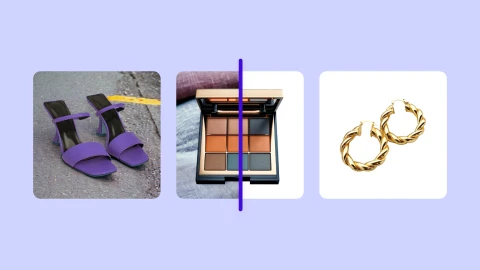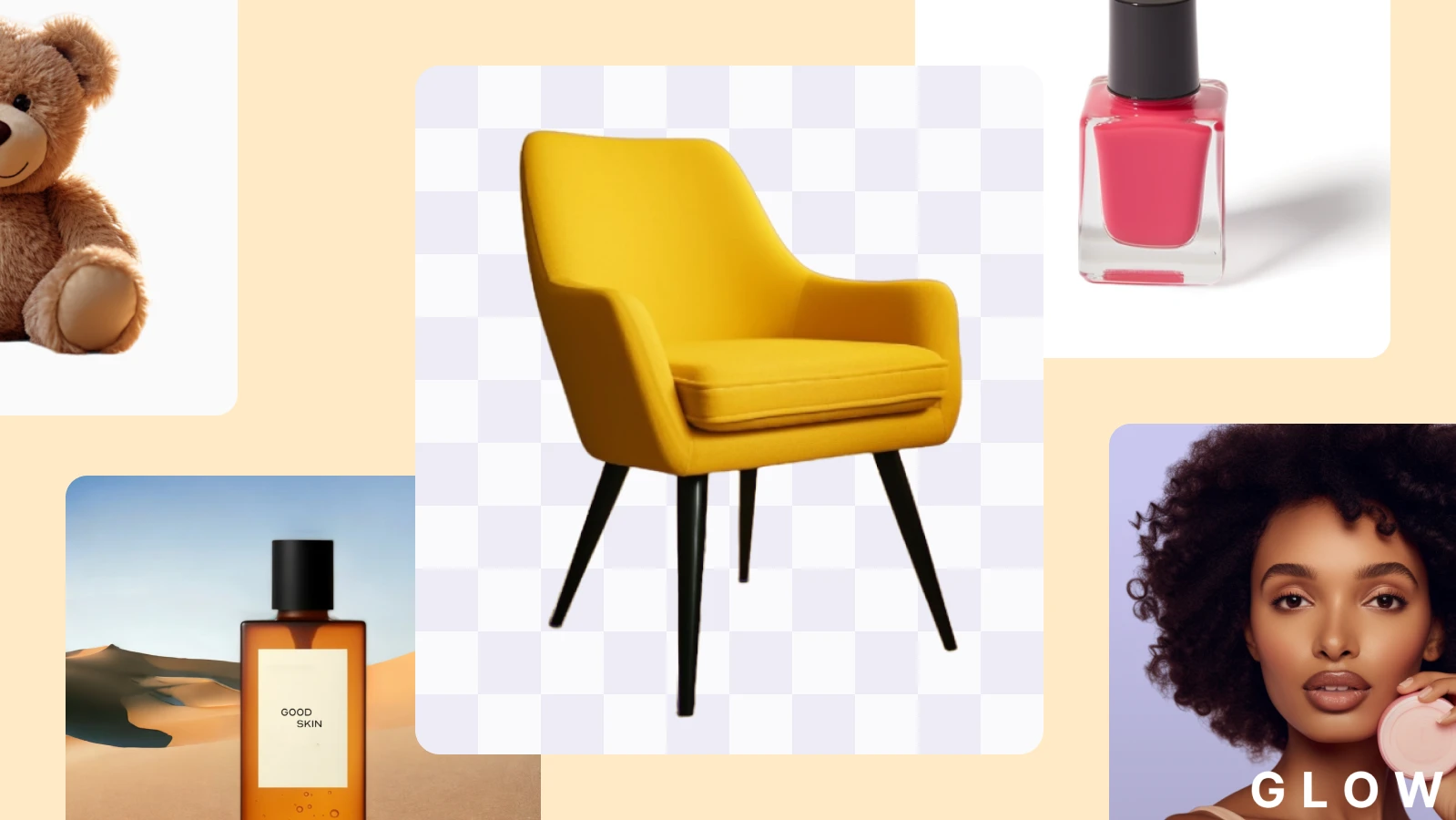Tips for product photography backgrounds (2025)


How you present products on your ecommerce website matters. 56% of users immediately explore product photos when they start browsing for items online. If they don’t like what they see, it’s probable that they’ll leave your site without making a purchase.
Everything about a product photograph matters: from the lighting to the composition of the image to the background.
Product photography backgrounds are a critical, but often overlooked part of an image. Selecting the right background, however, is easier said than done. You need to answer questions like:
What background will best complement your product?
What will accentuate specific features or benefits of the product?
What will allow you to convey the real-world usage or origins of the product?
What are you required to include when using the products online?
Is the background versatile enough for all of your needs?
And, in many cases, you will need to swap in and out different backgrounds to align with various needs—from campaigns to sales events to different marketplaces. This article will walk you through the various options for product photography backgrounds, and offer tips for tools and techniques that will help you get the best results.
The power of product photography backgrounds
The background of a product photograph is just as important as the lighting, framing, or focal distance. Different backgrounds evoke different emotions, helping you to position your product in creative ways.
White product backgrounds help to make a product image pop, and is a standard for many ecommerce stores and marketplaces. Colored backgrounds add emotion and thematic intrigue, and help to align the product photo with your brand or a specific campaign. Environmental or contextual backgrounds situate the product within a familiar or complementary setting, helping users visualize how they would use it.
Here’s an example of how each of the above background variations can create different compositions for a product image:
How to create new product photography backgrounds
There are two ways to create a background for your product photographs.
First is to use a tool like Photoroom to generate or create a digital background for your image. To do that, you would typically shoot your images against a plain white background, and swap in and out new backgrounds with the digital tool.
The second option is to physically stage your images against a real background that matches your desired aesthetic. For example, the product could be placed on a wooden table, a bed of grass, or any other surface that matches your desired aesthetic. On top - if needed, you can also add text to your photo.
The first option offers much greater versatility and time-savings. You’re able to shoot an image once, and then quickly swap in new backgrounds as needed. This not only offers a much broader number of background options to choose from, but dramatically speeds up production times and reduces DIY costs.
"Technologies like deep learning have impacted image editing with smart features like background removal, deblurring, face enhancement, and unwanted object removal,” explains Eliot Andres, Photoroom’s co-founder and CTO.
“Before these advancements, editing photos would take hours and hours, with people needing to painfully click all the pixels in an image to select the background or parts of the image. These new algorithms are saving people a lot of time.”
You may also like to read: 14 product photography ideas to boost online sales
How to find and create perfect product photography backgrounds
Selecting the right product photography backgrounds requires you to think about the destination for the image, the presentation you’re hoping to achieve, your target buyers, and the resources at your disposal.
Here are some general tips for ensuring the perfect product photography backgrounds.
1. Consistency is key
Clean and consistent backgrounds are a must for ecommerce brands. Ideally, backgrounds should be standardized on product shopping and category pages where consumers are comparing items.
This allows shoppers to easily compare products side-by-side. The only variation between product shots should be the items themselves. By doing so, customers can easily find what they’re looking for, and learn more about each product with the same level of detail and presentation as other items. This increases trust amongst consumers, and allows them to easily recognize and consider products.
Consistency also helps to create a uniform and easy-to-navigate user experience for the website. Imagine multiple rows of hats on a website—some with blue backgrounds, others with red backgrounds. The result will be a chaotic visual experience that may disorient and distract users from the items themselves.
The image below shows an example of consistent and uniform background usage.
2. Versatility with prompts
While versatility and consistency are critical for product photography backgrounds, small businesses often don’t have the time, resources or (potentially) skills to create numerous variations of the same product image. Multiply that by the number of products on a website, and the issue compounds significantly.
Photoroom offers a solution to this problem. Instant Backgrounds—a generative AI photo editing tool—lets you input customized prompts to generate new and unique background options.
Let’s take a look at two examples below. The first prompt is as follows:
“A gold ring on a velvet pillow, with a white wall in the background.”
 To create a second variation, you can input the following prompt:
To create a second variation, you can input the following prompt:
“A gold ring on a piece of glass, with a garden in the background”
 Neither of these backgrounds existed before we inputted the above prompts. This just shows the number of different variations that are possible through AI-driven background creation.
Neither of these backgrounds existed before we inputted the above prompts. This just shows the number of different variations that are possible through AI-driven background creation.
You might also be interested: Add a green background to your pictures
3. A library of options
In addition to custom prompts, Instant Backgrounds also offers a full library of pre-built or generated (through AI) backgrounds that you can add to your image in just a single click. These include solid colors, abstract patterns like the ones shown here in the Black Backgrounds library, and auto-generated lifestyle backgrounds.
With a simple upload of an image to Photoroom, you gain access to a wide range of background styles that cater to virtually any use, platform, or brand specification.
 Even better, this tool lets you create multiple variations of a single product image in a matter of minutes. This means that you only need to focus on taking a single round of high-quality product photos, and then quickly mix and match different backgrounds as needed for sales and marketing activities.
Even better, this tool lets you create multiple variations of a single product image in a matter of minutes. This means that you only need to focus on taking a single round of high-quality product photos, and then quickly mix and match different backgrounds as needed for sales and marketing activities.
“The different background templates and themes in Photoroom are great for lifestyle shots. They bring my product to life for customers and help to visualize it for them so that when I sell there’s an emotional connection with my customers.”
— Ian Nethercot, founder of Switchup Signs
4. Lighting and shadows
Lighting and shadows, in particular, have a direct effect on:
The level of detail visible in the photo
How true the colors of the product are to real life
How clearly the product is presented
What parts of the product are emphasized over others
The level of post-processing that can be conducted (high-quality, full light photographs can typically be altered more than those with dim lighting, faded colors, or heavy shadows.
The best product photograph is one that helps you present the product in the best possible way. Depending on the product, that might be full, direct light (jewelry) or the incorporation of shadows or dimmed lighting to create a specific mood (furniture or staged product photographs).
Again, it’s difficult to predict all the different variations of a product photo you’ll need during the initial shoot. With Photoroom, you can alter the lighting in post-production, add a shadow, retouch and remove objects from the image, and change the color of the image.

“Instant Shadows make my images look realistic. They don’t have that generic look so everything I have on my website looks like they are done in a professional studio and my products look more expensive, natural and effortless.”
— Marcus Aliaga, founder of ALLTRUEIST
6 types of product photography backgrounds
As mentioned, the type of product photography background you choose has an enormous impact on the staging and presentation for your images. Different colors, textures, and scenes can invoke drastically different impressions from potential buyers, impacting interest and sales.
Here are six types of product photography background to choose from. This list isn’t exhaustive, but should provide a good starting point to help you consider the best options for your products and business.
For each background type, we’ve included a sample image showing the same product against different colors, textures and scenes. All of these images were created with Photoroom, and demonstrate how a simple background change can alter the presentation of a product.
1. Plain white backgrounds
White backgrounds are the most common choice for ecommerce shops and marketplaces, with Amazon mandating it for all merchants. Apart from being a technical requirement on many sites, white backgrounds also have the benefit of directing the buyer’s focus to the product. They’re free from clutter and distraction, and allow merchants to create a clean, uniform look across their website.

2. Black backgrounds
Black backgrounds, like their white siblings, are great for creating uniformity across a site, and for maintaining focus on the product. The vibe of a black background, however, is different. With the right product, black backgrounds can invoke a feeling of mystery, elegance, or luxury.
Playing with the hardness or softness of a black background, along with using gradients and lighting techniques, and help create a unique composition that boosts interest and desirability.

3. Solid color or gradient backgrounds
Solid colors and gradient backgrounds are a great option for companies with a unique brand palette, or who are running stand-alone campaigns. Solid backgrounds invoke a variety of emotions and moods, depending on the color chosen. And, using a color that ties in with your brand creates a connection between the image, the product, and your company in the mind of the buyer.
Here’s an example of the product against a blue background.

And here it is against a yellow background. Notice how the product pops differently, and creates a different feeling and mood for the shopper.

When using colored backgrounds, it’s essential that you pick a hue that complements the product. You don’t want colors to clash, or for the background to overpower the object. This can take some experimentation and fine tuning, but will pay off big in the form of unique product images that stand out amongst the competition.
4. Patterns and shapes
Patterns and shapes can be used to give your images some pizazz, character, or playfulness. The options are nearly endless, ranging from subtle to extreme.
Examples of patterns include basic shapes like shown below, natural textures like woods or marble, or even entirely unique and abstract patterns that you create.
Again, you want to ensure that the background patterns don’t take attention away from the product. They should play nicely alongside the foreground object, but add an extra layer of intrigue to the image. This can be done either with physical objects or canvases during production, or with a digital tool like Photoroom.

5. Textured backgrounds
Textured backgrounds are a variation on the above, and help to place your product in a more natural setting. They don’t go as far as a full scenic background, but do draw a connection between your product and a familiar object.
In the image below, for example, the texture might invoke thoughts of a beach towel or a crisp blue comforter. That, in turn, might draw a connection between the product and a nice vacation.

6. Scenery backgrounds
Scenery backgrounds take the texture idea a step further and place your product within a clearly defined setting. This associates a specific lifestyle or activity with your product, allowing buyers to visualize how, where, and when they might use the product.
In this example, our hat is placed on a wooden bench outside at dusk. This may invoke a vision of wearing the hat to a soccer game with the kids, or sitting around a campfire with friends. Whatever the interpretation, scenery backgrounds help the buyer picture how they will use the product, and what benefit it will add to their lives.

Conclusion
Product photography backgrounds should be a top of mind consideration for ecommerce brands and photographers. But, you shouldn’t be locked into the background you select during a shoot. Photoroom lets you easily swap in and out different backgrounds to strike the right mood, align with a new campaign, or meet a technical requirement.
"Photoroom values creativity more than anyone, " explains Matthieu Rouif, co-founder and CEO of Photoroom.”
“Our goal is to create unique studio-quality visuals accessible to any business worldwide. We believe everyone can be creative if the tools given are powerful enough. We put the small business in the director's seat for visual creation; they only focus on the creative part, the story they want to tell. We take away the non-creative task of design creation, like removing backgrounds.”
Try Photoroom today. It’s accessible on mobile devices and can be downloaded from the App Store or the Google Play Store, or sign up on Photoroom Web. Set up your account in less than a minute, and start saving time and focusing on more important tasks right away.
Related articles:
How to create your Etsy listing photos
How to sell on Poshmark
How to sell fast on Depop

















